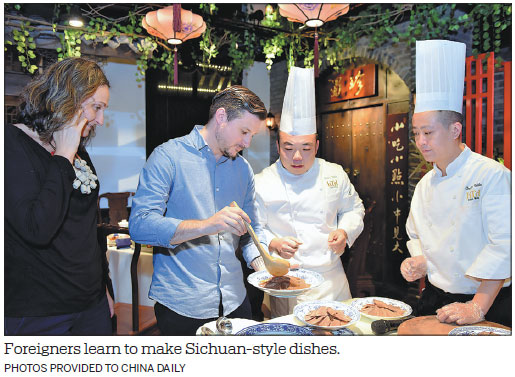Servings tantalize taste buds far and wide
With its centuries-long history and unceasingly enriched ingredients and flavors, Sichuan cuisine has developed into one of the most popular Chinese cuisines both in China and abroad.
The origins of Sichuan cuisine date back to the Warring States Period (475-221 BC), when local governor Li Bing constructed a water conservation project on the Minjiang River in the northwest of the Chengdu Plain, the largest plain in Sichuan province.
The project provided a great push in the development of Sichuan's cuisine by creating a prosperous economic environment with an abundance of new products.
The water conservation allowed for crops to be watered no matter drought or flood for the following more than 2,000 years.

The Chengdu Plain is rich in wild delicacies from the fish, shrimp and crab in its rivers, to its wide variety of livestock and perennial vegetables, bamboo shoots and edible fungi. The plain is also notable for the variety and quality of the spices grown there.
As a key source of supplies on the ancient Silk Road, an international trade route, Chengdu, the capital of Sichuan province, prospered from exchanges with overseas merchants and introduced a great number of new agricultural products, including cucumbers, walnuts, garlic and soybeans, further adding to the richness of ingredients found in the local cuisine.
Sichuan cuisine reached its piece de resistance during the Tang Dynasty (618-907), one of the most prosperous dynasties in China's history.
Among the most booming commercial and trade cities at that time was Chengdu, where deep-pocketed merchants, high-ranking officials and noble dignitaries paid great attention to their diet, demanding the best dishes to delight their taste buds.
From the late Yuan Dynasty (1271-1368) to the early Ming Dynasty (1368-1644) and from the late Ming Dynasty to the early Qing Dynasty (1644-1911), Sichuan cuisine began to develop into the modern flavor that we are familiar with today - that of being tantalizingly numbing and spicy.
During those two periods, many people from other provinces and regions, including Hubei, Jiangxi and Fujian provinces and the Guangxi Zhuang autonomous region, moved to Sichuan.
Those from the other provinces and regions brought with them their own food culture, blending it with that from Sichuan.
As modern Sichuan cuisine bubbled and burgeoned, chili imported from South America began to take root in Sichuan, providing the cuisine with its signature spicy kick.
However, despite chilies being synonymous with Sichuan cuisine, they are only used in one third of Sichuan dishes, according to the experts.
zhangdandan@chinadaily.com.cn
(China Daily 05/15/2019 page18)














